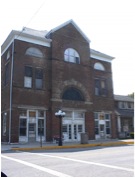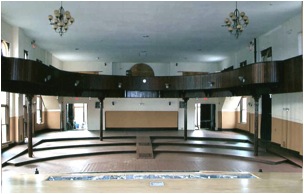Jamestown

Current Name of Theater: Jamestown Opera House
Current Type: Historical landmark
Seats: ? no fixed seating yet, 8,611 ft²
Web site: http://jamestownoperahouse.com/index.html
Historic Names of Theater: Jamestown Opera House
Address: 19 N Limestone St, Jamestown, OH 45335
Contact Info: Jamestown Area Historical Society, P.O. Box 162, Jamestown, OH 45335
Year Built: 1889
Romanesque Revival architecture
Original Architect: designed by John W. McLean and the firm of Matthew Moorman
Original Cost: $11,600
Listed on National Register: yes – 7001093

History of Theater:
Constructed in 1889, the Jamestown Opera House was the center of community activities for nearly 50 years. The facility is a significant example of a late 19th-century combination town hall, township house and opera house. Listed on the National Register of Historic Places, it also serves as an excellent example of the round-arched Richardsonian Romanesque style of the 1880s.
Cost of Rehabilitation:
Two prior state appropriations totaling $225,000 have been used for window replacement, exterior brick and facade renovation, as well as HVAC and electrical upgrades. The Jamestown Area Historical Society will utilize a state appropriation of $50,000 in Am. Sub. H.B. 699 of the 126th General Assembly to help fund painting and plastering of the upstairs auditorium. The project received approval from the Commission in May 2007.
Architect & Contractors: different companies used for different things
Source of Funds: State Appropriations. Jamestown Area Historical Society.
Renovation Story:
In 2007, the Jamestown Opera House was listed on the National Register of Historic Places, qualifying both because of its historically significant architecture and because of its place in local history. At the time, it was a work in progress, rather than being actively used for a specific purpose. It’s one of two Greene County opera houses on the Register, along with the Cedarville Opera House in Cedarville. Using more approximately $225,000 supplied by the state government in the late 2000s in two separate grants, workers installed new windows, improved the electrical and HVAC systems, and restored the exterior walls. Another grant of $50,000 was used to repaint and restore the auditorium. The renovation project concluded in 2010.
![]()

